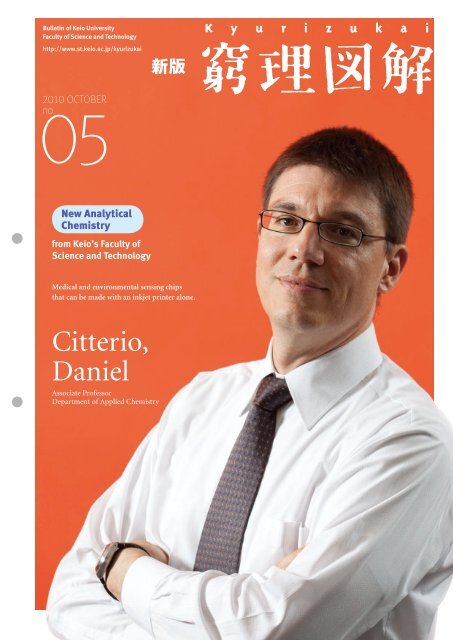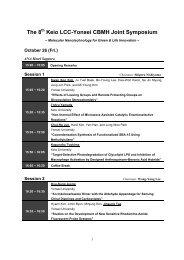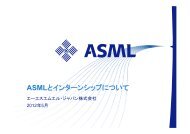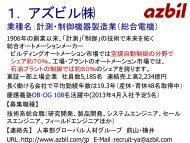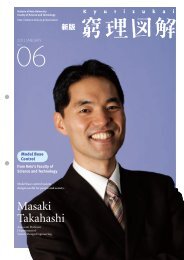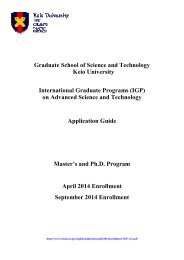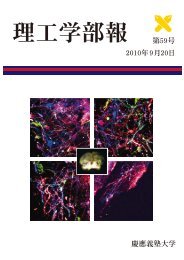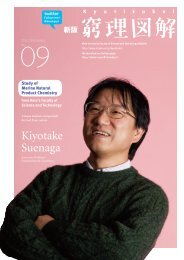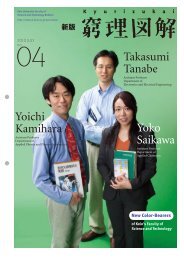Citterio, Daniel - Keio University
Citterio, Daniel - Keio University
Citterio, Daniel - Keio University
Create successful ePaper yourself
Turn your PDF publications into a flip-book with our unique Google optimized e-Paper software.
Bulletin of <strong>Keio</strong> <strong>University</strong>Faculty of Science and Technologyhttp://www.st.keio.ac.jp/kyurizukai新 版2010 OCTOBER05no.New AnalyticalChemistryfrom <strong>Keio</strong>’s Faculty ofScience and TechnologyMedical and environmental sensing chipsthat can be made with an inkjet printer alone.<strong>Citterio</strong>,<strong>Daniel</strong>Associate ProfessorDepartment of Applied Chemistry
IntroducingResearchersFeatured in this issue is Associate Professor <strong>Citterio</strong>, <strong>Daniel</strong>, who focuses on the developmentand practical implementation of a handy sensing chip fabricated by the inkjet printingtechnology.Creating Paper-based SensorsUsing Inkjet PrinterDevelopment of handy sensing chips for medical and environmental usesThe condition of one’s health can be judged by simply putting a drop of salivaor urine on a piece of paper and observing a color variation. Or the degreeof river pollution can be determined from a small quantity of river water . . .The development of such handy sensing chips is now in progress. All that isrequired to create the sensing chip is paper and an inkjet printer. We listenedto Dr. <strong>Citterio</strong> who addresses the development of innovative, highly usefulsensors by combining existing technologies with new “chemical sensing inks”specifically designed for this purpose.Fantastic paper-based sensors . . .No special equipment,not even a power supply,is required to use them!“What I’m focusing on are chemicalsensors and biosensors that can be carriedand handled by anyone and anywhere,making measurement quite easy,” remarksAssociate Professor <strong>Citterio</strong>.Among familiar examples of chemicalsensors are litmus paper for pH measurementand gas leak detectors.Furthermore, biosensors make use ofbiomolecules such as enzymes andantibodies to selectively recognize targetsubstances. One well-known example arepregnancy test kits. What Dr. <strong>Citterio</strong>aims to develop are handy sensingsystems that will allow instantaneousvisual recognition, like that of a colorvariation on litmus paper.SalivaPeriodontosisSystemic diseasesUrineDiabetesKidney diseasesMedical diagnosis byanalysis of body fluidsBloodHIVLiver diseasesCardiac infarction“In particular, I’d like to create handysensing systems for medical andenvironmental applications. Whenit comes to health management andmedical diagnosis, the sensing system willallow you, while at home, to check urine,saliva or blood for protein, blood sugarand hemoglobin conditions, for example.Regarding environmental applications,the system will make it possible to easilycheck drinking or lake water for pH valueor for the existence of contaminants suchas lead, cadmium and other heavy metalsas well as nitrite, arsenic, herbicidesand pesticides. Effective combination ofalready established sensing technologiesand their adaptation towards new inkjetprintable materials is my approach to thedevelopment of easy-to-use and highlypractical systems.”With this approach in mind, Dr.<strong>Citterio</strong> decided to employ “paper” asAnalysis of wastewater andother contaminated waterFarmlandsFactoriesHandy medical/environmental sensing chipThe use of this chip allows anyone to conduct medical tests with only a small amount of body fluid(saliva, blood, or urine) and to check wastewater or river/lake water quality – at low costs, promptlyand easily.the sensor substrate – filter paper madeof cellulose fibers. He thought paperwould be ideal as it is available anywhereeasily and for a low price, lightweightand handy to carry, mailable, easilystorable, and can be burned or discardedafter use. Presently available systems formedical and environmental analysis areof a large scale, their use requiring anair-conditioned laboratory and coolingequipment like a refrigerator. But apaper-based system would eliminate theneed for such equipment or even a powersource. This means great advantageswhen used at home and at fieldworksites and in developing countries wheremedical facilities are poor or insufficient.What’s more, it can be used easily evenunder emergencies.“In the world of chemistry, paper hasbeen used since ancient times. Chemicalscan be fixed to it and it’s capable ofwicking a solution by means of thecapillary action phenomenon. One fineexample is the established technologyknown as paper chromatography used toseparate chemical substances by virtue ofthese filter paper characteristics.The amount of reagent consumptionwould be minimized if various kinds oftests can be conducted by dropping onlyone drop of sample on to a small piece ofpaper. Given some reagents for examplebased on antigen-antibody reactionsare costly, it is very important to reducereagent consumption by reducing thechip size itself.Making chips withone single inkjet printerIn reality, several research groupsrecently began pursuing the method ofusing paper as sensor material. However,the originality of Dr. <strong>Citterio</strong>’s team lies inthe use of an inkjet printer based on thepiezo method (a method of jetting out inkby means of a piezoelectric element whenvoltage is applied to the print head).“Since more than ten years ago, researchefforts have been increasingly madeon Micro-TAS (Micro-Total AnalysisSystems) – devices for the analysis ofchemicals by combining microscopic2
Filter paperTest area1. Coat the filter paper bysoaking it in a solution ofpolystyrene (solvent: toluene).2. Print tolueneon the coatedfilter paper.Sampleinjectionport3. Print the chemicalsensing ink(test reagent).How to make a medical/environmental sensing chipThe sensing chip is made using the following processes ; (1) Soak the filter paper in a solution of polymer (polystyrene) for coating, making it hydrophobic ; (2)Use an inkjet printer to discharge an organic solvent (toluene) and make a channel. Polymer on the part to which toluene was applied is dissolved, therebycreating a hydrophilic channel ; (3) Then use the inkjet printer to print the sensing ink (test reagent) on the test area at the end of the channel.flow-channels, reaction chambers andmixing chambers on a minute chip. Glassand plastic chips have been used untilrecently. In 2007 Professor Whitesides ofHarvard <strong>University</strong> proposed paper chipsas a cheaper and easier solution.In association with paper, Dr. <strong>Citterio</strong>’steam set their eyes on an inkjet printercapable of jetting any desired controlledamount of ink. Today, inkjet printinghas grown into a highly generalizedtechnology, finding wide applications notonly for paper printing, but also for largesizecolor display films through to theproduction of microscopic items such assemiconductor substrates. This advantagemakes the inkjet printer very attractive,NO 2AtrazineweedkillerSalmonellaBO 33ScannerPO 43Ca 2+F pHSample injection portPb 2+Cu 2+Coliform bacteriaFig. A: Water-quality testing chipAnalysis bya scannerand PCNO 2BO 33PO 43Ca 2+Dr. <strong>Citterio</strong> says.“To make a chip, you basically put therequired reagents in the ink cartridgeand print onto paper. Then, simply usea pipette to apply a sample like blood orurine. Soon a reaction occurs. Besides,we are not only able to print chemicalreagents, but we also create microfluidicchannels on the chip using the inkjetprinter. It will be highly cost-saving ifwe can perform the entire chip-makingprocess with a single printer, you know.”The keys: the sensing ink and chip’smicrofluidic channel designF pHImagecaptureThe greatest challenge involved in theSimazineweedkillerPb 2+Cu 2+Fig. B: PC and color analysissoftware packageA handy system anyone can use anywhereWhen making a sensing chip, you print the sensing inks (test reagents) for your targeted testitems such as Salmonella and ingredients of weedkillers (Simazine and Atrazine) on the chip.Then, by simply placing one drop of the sample into the sample injection port, reactions willoccur in the respective areas, making it possible to measure multiple test items simultaneously (Fig.A). This sensing chip is not only suitable for visual judgment, but it is also capable of quantitativeanalysis if used together with a scanner. Systemizing it by combining with a PC, you can create aneasily portable, epoch-making sensing system (Fig. B).chip-making process is the developmentof multiple functional chemical andbiochemical sensing inks. For thispurpose, the creation of chemicallyfunctional materials in nanoparticulateform is essential.“With ordinary printer nozzles, thereare limitations to the liquid viscosity andparticle size that can be discharged. Also,you must ensure that the normally watersoluble reagents are not washed away bythe flowing sample, but stay firmly onthe test area so that color change occursuniformly, in a repeatable manner. So itbecomes important to exert ingenuitysuch as the use of small polymericparticles in the ink to prompt the reagentadsorption onto the paper.Although we still have a number ofchemical and physical problems to besolved, it would be fantastic if in thefuture we could develop a sensing systemwith which we can perform everythingwith an ordinary printer we’re using athome.”Another challenge Dr. <strong>Citterio</strong> is intenton is the design of the microfluidicchannels to be patterned on the papersubstrate – only 500μm in width.“We are making the flow-channelsand sensing areas by printing a patternon a piece of filter paper that has beendried after being soaked in a solution ofa highly hydrophobic polymer knownas polystyrene. Here we use toluene asthe ink, an organic solvent that dissolvespolystyrene. In other words, only theflow-channel and sensing area partsbecome hydrophilic. Chemical andbiochemical sensing inks are printed ontothose sensing areas to make the finalchip.If we succeed in making a good pattern,it will be possible to have one single pieceof paper accommodate multiple testitems.”Currently Dr. <strong>Citterio</strong> is also studyinga method of drawing a pattern usinga material that is more environmentfriendlythan toluene, accelerating theresearch work aiming for completion andlaunch within a few years’ time. (Reporter & text writer: Madoka Tainaka)3
InterviewListening to what Associate Professor <strong>Citterio</strong>, <strong>Daniel</strong> saysJapan is complete with anexcellent research-encouragingenvironmentMr. <strong>Citterio</strong> is devoted to the development of handy paper-based sensors thatanyone, not only specialists, can handle with ease. Eight years have passedsince Mr. <strong>Citterio</strong>, born in Zurich, Switzerland, came to Japan to engage inresearch work. He praises Japan as an attractively fertile soil for researchpursuits thanks to strong bonds among researchers as well as an excellentresearch environment relatively favored with both ample budgets andadvanced facilities.When did you come to Japan?My first visit to Japan was in 1996when I was a doctor course student atthe Swiss Federal Institute of Technologyin Zurich (ETHZ). At that time I hadan opportunity to participate in a jointproject and belonged to the Chemical andBiosensor Laboratory at the <strong>University</strong>of Tokyo’s Graduate School of Science,staying for three months.With universities in Europe, students innatural sciences usually find employmentafter completing a doctor’s course andthen pursuing postdoctoral studiesoverseas for at least one year. Many ofmy fellow students liked to study in theUnited States, but I didn’t want to gothere. This was because, rather than forthe sake of research only, I also wantedto broaden my horizons in life. In otherwords, I wanted to take up new challengesin a land where culture and language aretotally different. So I made up my mindto study as a postdoctoral fellow in Japan,the destination I had visited as a doctorcourse student.To tell the truth, during my first visitto Japan I had an opportunity to visit<strong>Keio</strong> <strong>University</strong> for only one day. Onthat occasion I paid a visit to ProfessorSuzuki’s lab, to which I belong now. Ilearned that Professor Suzuki’s lab isengaged in research close to that of mine.Finding that students there were all openmindedand easy to communicate with, Ihad a good impression of <strong>Keio</strong>.It was in March 1998 that I revisitedJapan as a postdoctoral fellow of <strong>Keio</strong><strong>University</strong>. My initial plan was to stay forone year. But as I got accustomed to myresearch life in Japan, I began to think itwould be a waste of precious opportunityif I left Japan as initially planned. Ourlab’s atmosphere was so comfortable thatI postponed my return again and again.As a result, I had stayed in Japan for fourand a half years in total.Did you acquire your Japaneselanguage ability in those days?Yes. In my early years I could hardlyspeak Japanese, which put me in troubleeven for shopping and other dailymatters. But my Japanese graduallyimproved thanks to once-a-week Japaneselessons from a private teacher and dailycommunication with students on thecampus.Later, in 2002, I returned to Switzerlandand began to work as an assistantprofessor at a university. Meanwhile, Ibecame interested in patents by that timebecause our <strong>Keio</strong> lab had obtained severalpatents. So I acquired a patent attorneyqualification by entering a universityagain to study.Armed with these careers, I once foundemployment with a Swiss chemicalmaker, but left this company a year laterand returned to Japan.Why?I had long enjoyed a life steepedin unrestricted research activities,conducting experiments at universitylabs and writing theses. But the momentI joined the company, such lifestylewas lost, which caused me to entertainanxiety about my future. I thought I wasa researcher type after all.In the meantime, Professor Suzuki waskind enough to invite me to participatein a new project. I thus came back to<strong>Keio</strong> <strong>University</strong>’s Faculty of Science andTechnology in 2006 as a non-tenuredassociate professor. From the academicyear 2009, I became a full-time associateprofessor.From 2007 on I focused on researchinto paper-based chips using the inkjetprinter. I think <strong>Keio</strong> is complete with a4
superb environment for researchers.You mean it’s a favorable environmentfor researchers?When we propose a research projectand it is accepted, the university offersan adequate support environment andwe can proceed with the project almostunrestrictedly. This is a great merit.Things seem to be changing a bit thesedays. Even so, I think Japan still offers anenvironment in which research budgetsare available relatively easily. I also noticestrong bonds existing among researcherslike Professor Suzuki. They all valuemutual human connections, which isgood. For example, even when you wantto know about something that is outsideof your own specialty field, you canconsult a specialist of that particular fieldthrough a network – a great environment.By the way, is your name Italian?Yes. This is because my ancestorsimmigrated from the northern part ofItaly to Switzerland. My father was bornin Switzerland while my mother had twonationalities: German and Swiss. Mymother tongue is German.<strong>Citterio</strong>, <strong>Daniel</strong>By creating and combining functionalmaterials (dyes, polymers, etc.), his researchwork focuses on the development of (bio)chemical sensors for application in industrial,medical, and environmental analysis. Born inZurich, Switzerland, he graduated from theDepartment of Chemistry of the Swiss FederalInstitute of Technology (ETHZ) in 1992 andobtained his Doctor degree from the sameschool in 1998. After postdoctoral research at<strong>Keio</strong> <strong>University</strong>, he became a research associateat ETHZ. Through postgraduate studies, heobtained a Masters degree in IntellectualProperty and joined a Swiss chemicalmanufacturer as a patent attorney. In 2006, hereturned to <strong>Keio</strong> <strong>University</strong>, were he became atenured Associate Professor at the Departmentof Applied Chemistry in 2009.Incidentally, as a small boy I was notparticularly interested in becoming ascientist. Rather, I wanted to becomea pilot but gave up the dream becauseof weak eyesight. Somehow I was goodat foreign languages (English, French,Italian and Latin) at school, which mademy teacher recommend me to major inforeign languages in the future. Though Iundoubtedly liked foreign language study,I didn’t think I would choose foreignlanguage study itself as my profession.What I am today as a researcher maypartially be the influence of a highschool chemistry teacher who livedin a neighboring condominium. I stillremember him telling me many thingsabout chemistry while giving me a rideto school. At one time I was absorbedin a chemical experiment kit for juniorhigh school students. Due to failure ofan experiment one day, I discolored“I love conducting experimentsand writing theses in my lab …I found myself suitedto be a researcher.”the wallpaper of my room into brown.(laughter)You like to use your own hands tocreate something, don’t you?Yes, I do. In fact, I’m also good atcooking. In a way cooking is similar tochemical experiments, you know. InJapan I’ve been living in the Hiyoshiarea. Living a single-life, when I havetime I often invite friends or some of mystudents and treat them to dishes of myown cooking.Since I like to move not only my handsbut also the whole body, I often enjoyoutdoors on days off – activities likecycling, skiing and hiking. I was surprisedto find few young Japanese people takingup hiking as outdoor recreation. Givensuperb scenic attractions in Japan, I’dlike more and more students to enjoywhat nature has to offer. I recover vitalityneeded for research work through suchoutdoor leisure activities.◎ Just a word from . . . ◎● A student: <strong>Daniel</strong>-san is frank and easy tocommunicate with. All of us follow him likeone of our seniors. Not only does he allowwhatever we like to challenge, but also heis always willing to give advice. He is a trulyreliable teacher.(Reporter & text writer: Madoka Tainaka)For the full text of thisinterview, please refer to:http://www.st.keio.ac.jp/kyurizukai5
Q&A with Associate Professor <strong>Citterio</strong>Q : Why did you choose Japan and what meritsdid you find in working here?A : I chose Japan because I wanted tolead a challenging life as a researcher inan environment with a different culturalbackground. Once settled in Japan, I found thiscountry very favorable for my research activities.First of all, I found it relatively easy to obtainresearch funds. Another merit was easy accessto a network of human connections, which isvitally important for developing research workin this country. In this respect I owe much to myteacher, Professor Suzuki, who is a leading figurein his field and keeps many valuable connectionsin and outside of <strong>Keio</strong>.“Japan as seen from foreign countries;Foreign countries as seen from Japan”Q : When it comes to studying overseas, Japanese students appear ratherreluctant whereas students from other Asian countries are very positive.What do you think?A : According to my observation, Japanese students are also motivated todo so. Given the prolonged recession, they tend to become hesitant forfears that the chance of finding employment may be delayed by at leastone year. Some students opt to study abroad only after having securedtheir employment though . . . I’m always trying to take students with meto participate in international conferences. This often turns out successfulbecause such occasions stimulate students’ intellectual appetite and motivate them tostudy overseas.I think that <strong>Keio</strong> <strong>University</strong> is providing its students with sufficient opportunities inthis respect. <strong>Keio</strong> maintains double-degree programs* with some overseas universitiesand an internship collaboration agreement with the Swiss Federal Institute ofTechnology Zurich (ETHZ), my alma mater. Opportunities are not few. The foremostreason for this problem is that students are concerned about employment. This is myimpression.Q : In what ways do you think humanconnections are important in Japan?A : In Japan human relationships amongresearchers are strong and exchange ofinformation among them is relatively open.Though I have no experience of workingin the United States, my impression is thatindividual researchers there are moreinclined to protect their own worlds thanthose in Japan.(*Double-degree program: This program allows astudent to obtain double degrees simultaneouslyfrom <strong>Keio</strong> and an overseas counterpart inagreement if the student has completed aspecified curriculum mutually agreed upon bythe two universities. Currently <strong>Keio</strong> <strong>University</strong>(Faculty and Graduate School of Science andTechnology) maintains such programs withIntergroupe des Ecole Centrale (France) andLund <strong>University</strong> (Sweden).)“Encouragement ofCosmopolitanism”Q : What points do you think are importantfor <strong>Keio</strong> students to develop activities oninternational scenes?A : First and foremost is the ability tocommunicate in English. Suppose youcan communicate fully in English whenparticipating in an international conference,even if you are a master’s course studentyou’ll be able to make a presentation onone-of-a-kind research achievements ofyour own, which gives you great confidenceas a researcher. If you lack the ability tocommunicate in English, especially thatconcerning your own specialty field, thehurdles will remain high. So I’m always tellingmy students to lower the hurdles of languageto begin with.Q : Mr. <strong>Citterio</strong>, you are proficient in Japanese in addition to German (yourmother tongue) and English. Do you have an aptitude you can recommend to<strong>Keio</strong> students?A : To learn Japanese, I began by listening to rinko* sessions held in Japanesein our lab and at seminars. To master technical terminology, listening isparticularly important since good dictionaries are rarely available. As forEnglish, I’d suggest students listen to lectures by overseas researchers. Bymerely listening to lectures in English, you can substantially increase yourknowledge of English technical terms. I’d like them to avail themselves tosuch opportunities as much as possible. This is the way I learned Japanese. SoI can now read theses written by students in Japanese, although I still findit difficult to read more common Japanese sentences as found inmagazines and the like.(*Rinko: Rinko is an occasion wherestudents report on the progress oftheir respective research activities anddiscuss their contents and directions.In some cases, rinko is held to readimported books and original theseswith students taking turns, or to solvefundamental problems.)6
● The Chemistry of Inkjet Inks-In EnglishThis book is relatively new in my personal library. As an Analytical Chemist specialized in thedevelopment of chemical sensors, I felt that I did not have sufficient background knowledgeabout inkjet printing inks. However, in my recent research, I need to transform the reagentmixtures required to create a chemical sensor into an inkjet printable liquid. The booksummarizes most of the important factsand properties that are important for inkjetprintable fluids. I think that the informationpresented in this book would otherwise onlybe accessible by extensive search of thepatent literature.● Advanced Bio/Medical Devicesand Equipments for Health Care-In JapaneseIn this book, my name appears as a coauthor(of one chapter), since one of my graduatestudents summarized his research work oninkjet printed healthcare chips. Each chapterintroduces a different device/technology,which is still not standard in health care,but which might become so in the future.Hopefully, our own inkjet technology will beamong those. The book provides an overviewover the latest research progress at Japaneseuniversities, research centers and companies.● Chemical Sensors and Biosensors forMedical and Biological Applications-In EnglishThis is a very relevant scientific textbook in my research field. At the same time,I have a specially close “personal relationship” to it. The author of this book ismy former Ph.D. supervisor at the Swiss Federal Institute of Technology (ETH),and it was actually written while I was a doctoral student. Therefore, most ofmy former laboratory colleagues and I have at some time been involved in the“creation” of this book, both by providing scientific data and by supportingthe editing and formatting of the text. The present copy of the book is actuallya gift including a personal handwritten note from the author, which I receivedon the occasion of completing my doctoral thesis. I still refer to this book inmy daily scientific work.● The Craft of Scientific Presentations-In EnglishThis is a book that I can recommend for all scientists, no matterwhether being a student or a professor. Before I first read thisbook, I could not imagine that a systematic introduction intothe “art” of scientific presentations would be so helpful. Thebook provides not only goodadvice for presenters, but it isalso fun to read. It makes youthink more about your ownstyle of presentation, aboutwhat could go wrong duringa scientific talk, and aboutthe way that you design yourpresentation slides. I am usingthis book as the basis of mygraduate student course“Presenting and DiscussingScientific and TechnicalSubjects in English”.● Culture Shock Japan-In EnglishI bought this book shortly before coming to Japan for the first time in my life in 1996 as a visiting student at Tokyo<strong>University</strong>. The book is intended to act as a guide to customs and etiquette for “gaijin” who are not familiar withJapanese tradition and behavior. I must say that the book was indeed helpful, especially during my first few monthsin Japan. I remember for example referring to it before attending a Japanese wedding ceremony for the first time.On the other hand, daily life in Japan taught me that not everything is as “strange” as described in the book. At theend of the book, there is a quiz where you can test your knowledge about Japanese customs. How about testingyourself to find out “how Japanese” you really are?7
Spin-offs Cominginto BloomAssociate Professor <strong>Citterio</strong>'s researchproject is an outcome of a flexibleconcept: “Wouldn’t it be possible to createsensors for medical and environmentalapplications using the micro-nozzletechnology originally developed forprinting?” There are similar cases like thiswhere a certain technology, originallydeveloped for another purpose, canbloom into a new, unexpected flowerby adding some novel ingenuity to it.These are known as technological “spinoff”, representative examples being spacedevelopment technologies.The laser, now popular in lightingand other fields, was developed for theApollo Program to accurately measurethe distance between the Earth andthe Moon. Today its applications rangewidely from CD and DVD equipment,processing equipment and medicalequipment through laser fusion.Laser equipment for space use mustclear various requirements, such as beinglightweight, robust, compact and highperformance capable. For example, whatis known as the truss was contrived bycombining triangular frames in orderto make a robust cylindrical structurewith a limited material. An applicationof this technology in beverage can designis the shiny “diamond-cut can” for thepopular “Can Chu Hi” alcoholic drink,which won a packaging design prize inJapan. In another example, the idea ofsmall CCD camera, developed to monitorplant experiments in the Space Station, isapplied to a pill-type gastroscope (9mmin diameter and 23mm in length).Furthermore, the “organic wastetreatment technology” vitally neededfor humans to stay in outer spaceover a long period is applied to wastetreatment technologies on Earth –typically, the recycling of organic wastefrom alcoholic beverage productionprocesses and excretions from livestockfarming into water or energy resource,thus contributing to environmentalbetterment.What flowers will advances ofMr. <strong>Citterio</strong>’s research bring next?Expectations are high.新版05Science and Technology InformationThe 11th KEIO TECHNO-MALL 2010 held under the theme“Transcendental Powers”http://www.kll.keio.ac.jp/ktm/December 10 (Fri.), 2010 (10:00 ~ 17:00)Tokyo International Forum (Halls B7 & B5)Admission free, no prior registration requiredKEIO TECHNO-MALL is an annual science and technology exhibition held by the <strong>Keio</strong> LeadingedgeLaboratory of Science and Technology (KLL). It introduces a diversity of research achievementsand new technologies developed by <strong>Keio</strong> <strong>University</strong> with approximately 70 booths for demonstrationsand exhibits. This year’s concurrent main event will feature a talking session by guests under thetheme “Process from Research to Commercialization: Roles played by academia, industry and thegovernment, and the future.”Strategic Management Chair for Creating Innovations(a Sony-donated chair)Open Symposium 2010“Toward a New Phase of Development of Humankind and Society: TheFuture of Science, Technology and Humankind”http://www.koukai-sympo.net/January 14 (Fri.), 2010 18:00~Kyosei-kan Fujiwara Hiroshi Memorial Hall on the <strong>Keio</strong> <strong>University</strong> Hiyoshi CampusAdmission free; Prior applications requiredThis event is the last of a 3-round-series open symposium by an endowed chair established at the <strong>Keio</strong>Graduate School of Science and Technology. Mr. Mario Tokoro, President of Sony Computer ScienceLaboratories, Inc. will preside over the symposium, inviting Professor Junichi Rekimoto (GraduateSchool of Interfaculty Initiative in Information Studies, The <strong>University</strong> of Tokyo) and other scientistsfor discussion. Please apply for participation at the above URL. A movie showing last year’s symposiumis available:Open Symposium 2009 http://21722lab.jp/#/basic/detail?id=361A scene from Open Symposium 2009新 版c <strong>Keio</strong> <strong>University</strong>Editor’s postscriptAs I knocked on Associate Professor <strong>Citterio</strong>’s lab for an interview, students rushed around Mr.<strong>Citterio</strong> in a moment at his welcome and began talking cheerfully. As you can see in “Just a wordfrom . . .” at the end of the interview (page 5), Mr. <strong>Citterio</strong> is called by his first name “<strong>Daniel</strong>-san” byhis students and apparently maintains frank and friendly communication with them. When we wereabout to take photos for the “My favorite books” corner, Professor Koji Suzuki of the same lab poppedin and said “How about this book?” I could feel a truly harmonious and cooperative atmosphereprevailing in this lab.The next issue will feature an up-and-coming assistant professor from the Department of SystemsDesign Engineering. Please look forward to the next issue. (Saori Taira)New KyurizukaiNo. 05 October 2010Editing: “New Kyurizukai” Editing CommitteePhotographer: Keiichiro MuraguchiDesigner: Hiroaki Yasojima (GRID)Cooperation for editing: SciTech Communications, Inc.Publisher: Tojiro AoyamaPublished by: Faculty of Science and Technology, <strong>Keio</strong> <strong>University</strong>3-14-1, Hiyoshi, Kohoku-ku, Yokohama, Kanagawa 223-8522Web version: http://www.st.keio.ac.jp/kyurizukai


